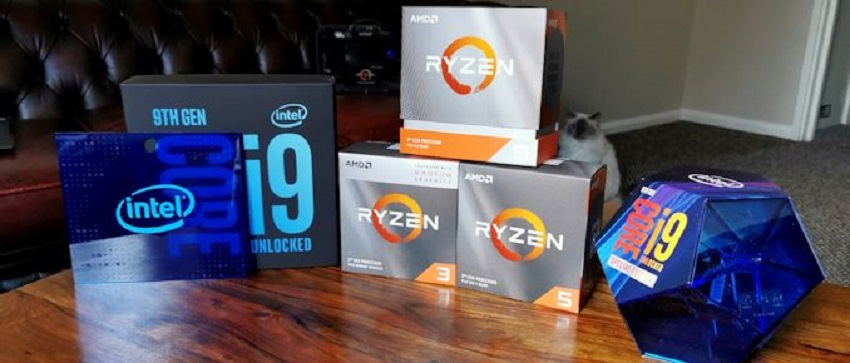Choosing between the best Intel or AMD processors on the market may not be an easy task, you must choose a unit that is consistent with the rest of your equipment and that suits your needs. In the market we find a multitude of processors with prices ranging from 70 euros to approximately 1000 euros, to help you in your choice we have prepared this guide with the best models for each need. This way it will be easier for you to know which models that are currently hitting the hardest.
Characteristics of a processor to consider
The first and most important thing to finding the best CPU is to know its main characteristics and how they will influence its performance. It is about choosing, not the cheapest or most expensive model, but the one that best suits what you are looking for in your ideal desktop PC.
Cores vs Threads
The cores are the fundamental part of a processor, the elements that process the information generated by the operating system with its applications and tasks. These entities are defined by the architecture, in PC we speak of x86, and by the manufacturing process or transistor sizes, 12nm, 10nm, 7nm, or 5nm.
All this is important when it comes to knowing the CPU and the rest of its characteristics because every year manufacturers release a new generation in which all these aspects that define the architecture of the cores change. The fewer nm they have in their process, the more cores they will a priori fit and the more efficient they will be.
To get around frequency caps manufacturers increase the number of cores in their CPUs. In this way, the more number of cores we have, the more tasks can be processed in each cycle. An 8-core CPU will be twice as powerful as a 4-core CPU on the same architecture, so you can handle more tasks at the same time.
E-Core and P-Core in Intel vs AMD Chiplets
In the definition of cores above, there is a new trend that started with portable devices that have now also been adopted by Intel starting with its 12th Gen Alder Lake. It is about the Efficient Cores and the Performance Cores or E-core and P-core, already present in ARM architectures such as Apple or Qualcomm, which do not seem to be implemented in the next AMD CPUs.
Both will be physical cores, the P-core will be the cores that we know so far in CPUs, larger, with high frequencies, and provided with 2 threads. They will be perfect for very demanding continuous tasks, for example, rendering or gaming. For its part, the E-core is smaller, with a single thread and working at a lower frequency, ideal for tasks in the background of the system, short, and of various types. Intel encapsulates it all in single silicon, plus the cache and integrated graphics.
For its part, AMD uses only high-performance cores, but instead of putting them all on single silicon, it divides them into blocks called CCDs or Chiplets. Each one has 8 cores, its own cache block, and a bus that distributes data. A priori it provides more expandability than the Intel architecture, although longer data lanes influence the raw speed. On paper, this should be the most efficient model to follow in the future, but P-core + E-core still works better.
Speed and turbo boost
When we talk about processing speed we talk about the clock frequency of the cores or hertz (Hz). The faster a CPU is, the more tasks it will process per unit of time, but the more heat and stress will be generated on the chip. The more speed the better, but it will be better to have slower physical cores.
All CPUs have a base clock frequency, a maximum frequency across all cores, and one or more turbo boost modes. With the one or two cores are able to raise the maximum frequency for a certain time to obtain more performance.
Cache
It is the second most crucial element of the CPU, consisting of a much faster and smaller memory than the RAM directly integrated in the processor, storing the data of imminent use by the CPU. Its function is key to eliminating the bottleneck that can occur between the processor and the RAM, which are much slower in terms of performance.
Current PC CPUs have 3 levels of cache the largest and slowest L3 (we’re talking about 10 times faster than RAM), to the much smaller and blazingly fast L1 (1600 GB/s or even more). Unfortunately, we cannot choose the cache of a CPU, and we have to settle for the one that comes with the model in question.
North Bridge or I/O interface
The northbridge is currently inside the CPUs, being silicon physically apart from the cores with everything that has to do with transporting information to or from the processor. This element will largely determine the type of memory and motherboard that we can install in our PC.
In the NB we have the addressing with the RAM memory, which can be DDR4 or even DDR5 currently, and we also have part of the PCIe Lanes for the expansion slots, which can be PCIe 3.0, 4.0, or 5.0. The bus that links the cache with the North Bridge is called BSB (Back-Side-Bus)
TDP vs TjMax
The TDP or Thermal Design Power is a measure that defines the measure of thermal output or amount of heat that a component under stress will generate, measured in Watts (W). Be careful of this because it is not the consumption of the component, but rather it has to do with the heat. The larger this measurement, the larger the heatsink should be.
Intel CPUs currently have a TDP Boost that dynamically raises the base metric to increase drive performance if cooling and temperatures allow. Likewise, the TDP can also be lowered automatically or manually if the CPU reaches its maximum internal temperature or TjMax, limiting its performance. We would call this Thermal Throttling.
Socket
The socket or socket is basically the socket where the CPU will be installed on the board, varying between generations and manufacturers. This is more important when buying a board, but we must always ensure that it is compatible with the CU we intend to buy.
It will also directly influence the type of heatsink that we can place and its mounting system. We currently find Intel processors under the LGA 1200 and LGA 1700 sockets, and AM4 and soon AM5 sockets for AMD.

